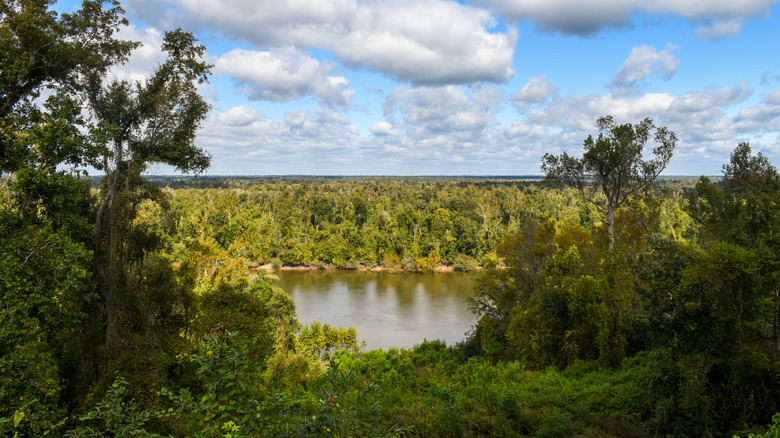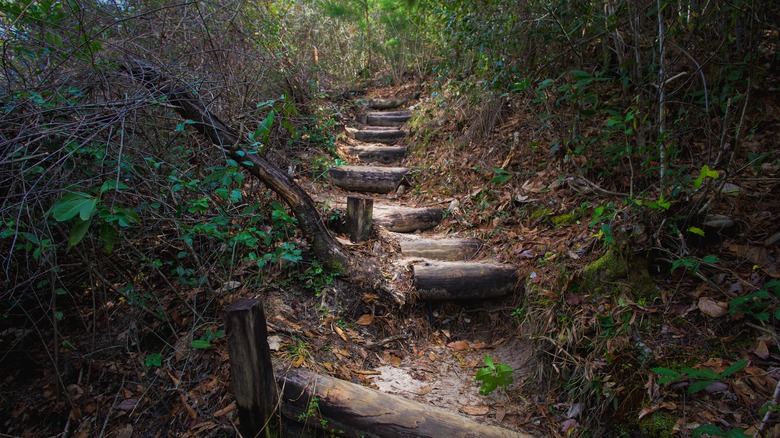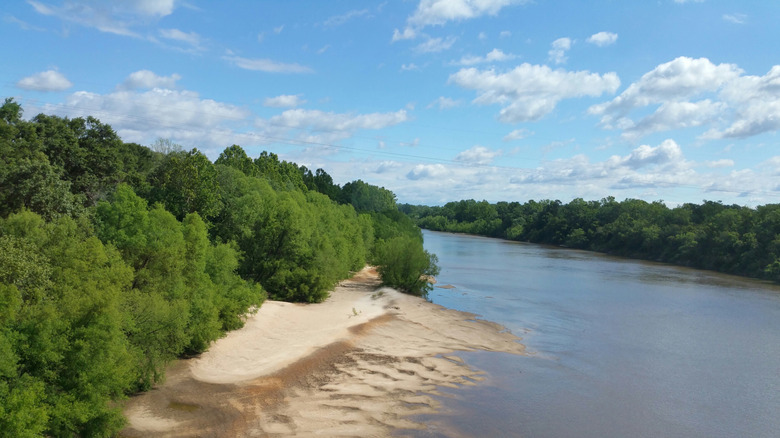Florida's One-Of-A-Kind Panhandle Trail Is A Secret Wetland Path To A Breathtaking River
In just a bit less than four miles, hikers visiting the Florida Panhandle can take in a viewscape that will have them wondering if they are, indeed, in the Sunshine State, and what has become of Florida's traditionally flat and swampy landscape. Along the Garden of Eden Trail, which is situated about an hour's drive northeast of Panama City, hidden away amongst the pines and sandhills along the Apalachicola River, the view looks distinctly "un-Florida" as high bluffs and sometimes-steep terrain make for a unique walk in the woods. In short, this "secret" path is unlike the state's other notable and more beachy "Old Florida" Panhandle destinations.
The Garden of Eden Trail is maintained by The Nature Conservancy within its Apalachicola Bluffs and Ravines Preserve and is located near the town of Bristol, Florida. The trail winds through the woods and up and down some modest sandhills and bluffs, so hikers expecting a typically Florida-flat walk through the trees might be a bit surprised at the elevation gains and losses as they approach the river. Along this unique walk, visitors will see some very unique flora, including mountain azaleas, Florida anise, and flowering prickly pear. But perhaps the most unique plant specimen that might interest budding botanists is the Torreya pine tree, which is found along this reach of the Apalachicola River and nowhere else in the world.
The trail offers the highest viewpoint above a Florida river
The Garden of Eden Trail leads hikers to an honest-to-goodness overlook where they can get a bird's-eye view of one of the South's great rivers — the Apalachicola. Such an elevated viewpoint is rare for Florida, a state that's hardly known for its remarkable topography. Yet, from atop Alum Bluff, hikers find themselves 135 feet above the river and its vast wetland floodplain — the highest natural geologic point above a river in the state. The hike actually follows the tops of several steephead ravines, another unique geological feature that can be seen from the Garden of Eden Trail. It's as unique as any other Florida Panhandle destination.
These ravines, which have been carved out of the sandhills for eons, provide important habitat for a variety of watchable wildlife. Some of the critters found along the trail within the preserve include gopher tortoises, eastern fence lizards, and one of Florida's most treasured reptiles, the eastern indigo snake, which is the largest snake native to North America. The docile reptile is non-venomous and listed as threatened under the federal Endangered Species Act, and the trail slices through some of its most important habitat, so it's important to follow the trail's rules and guidelines.
As for the other critters that might make an appearance on the totally doable day hike to the river, you'll want to keep one eye on the skies for soaring bald eagles and the other eye on the surrounding Torreya pine and long-leaf pine woods for wild turkeys and American woodcocks.
How to make a day of it on the trail
Though camping is not allowed along the Garden of Eden Trail, it makes an excellent day trip from a campsite at the nearby Torreya State Park, one of Florida's more scenic state parks. There, visitors can pitch a tent in the park's primitive campground, hook up an RV in one of 30 shaded sites with electric and water connections, or rent the park's unique yurt, a large, domed structure that can sleep four guests and provides amenities like electricity, windows, and flooring. The trailhead is just minutes away from the state park, so within an hour or so of pitching camp, hikers can be well on their way through the bluffs and ravines to the scenic Apalachicola River.
Other than two crossings of a small creek — the Kelly Branch — the trail is largely dry. Hikers are advised to bring plenty of water and enough provisions for a full day on the trail, particularly if they are walking with kids. In addition to the topography, which might be unfamiliar to most Florida hikers, visitors to the Garden of Eden Trail should stop now and then to soak in the sights or get a better look at some of the bug life, like the many ant colonies that can be seen from the trail or the dragonflies and butterflies that flit across it as the pathway winds closer to the river. The reward at the end — the view of Alum Bluff and the mighty Apalachicola River — is worth the slightly strenuous hike through this unique slice of Florida.


